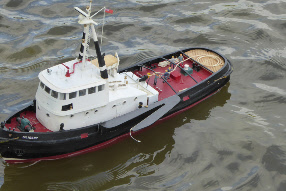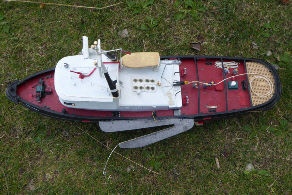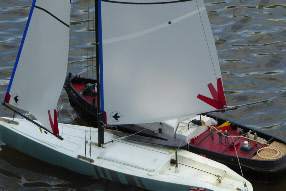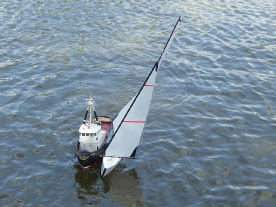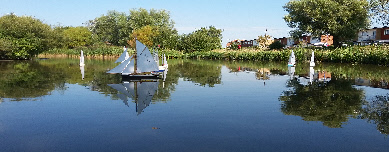
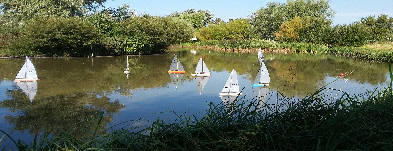
Selsey Model Boat Club
Here is Richard Hoare’s article written for Model Boats Magazine.
TUG conversion to RESCUE BOAT
At Selsey MBC, we regularly race Victoria yachts on our pond, which suffers from a tree line to the south and a tree covered island to the north-west. These cause areas of doldrums in an otherwise breezy location. You would not be surprised to learn, that on occasion, yachts get stranded around the banks and in the areas of no wind.
I built my model of the tug Diligent from one of the free plans provided by Model Boats and it has proved to be a sturdy and powerful vessel. Fitted with two geared motors and a P94 mixer/twin-ESC (from Action Electronics) it is also very manoeuvrable.
In a moment of inspiration, I thought it would also make an excellent rescue boat if a suitable method of ‘catching’ the yacht could be devised. After a couple of less than successful designs were rejected the idea of an elongated ‘hook’ came to mind. Initially it was very difficult to catch the other craft until a wire extension was epoxied in place to widen the mouth – see picture 1 and 2. Ideally, the plan is to slowly approach the stricken boat along its starboard side so the hook engages on the shrouds amidships – see pic 3.
Assuming the yacht is still under radio control, it is best to set the sails to close hauled (i.e. as tight as they will go along the centre line of the hull). The tug can then be steered back to our landing stage for recovery of both vessels. Simple!
On the day these photos were taken, it was windy and a new member’s boat, an DF65, went fast aground at the shallow end of the pond. Diligent was launched and collected the boat without difficulty – see pic 4. However, if you are thinking of trying this idea for yourselves, the host vessel does need to be powerful to overcome any adverse windage in the yacht’s sails. Also, fine speed and rudder control makes ‘hooking’ the distressed yacht so much easier.
A refinement currently under design is a latching device to lock the shrouds into the base of the hook and possibly another similar arrangement fitted to the other side of the tug. Incidentally, the hook assembly is removeable, being located securely into two of the scuppers in the port bulwark and fixed in place with a brass hook which secures it on one of the midship bollards.
I hope this solution is helpful if you ever need to recover a broken-down yacht. It will also recover power vessels if there is a suitable piece of superstructure to hook on to.
Happy sailing!
Richard Hoare
Secretary, Selsey MBC
Here is an interesting Article by Peter Fisher on rounding marks and roundabouts.
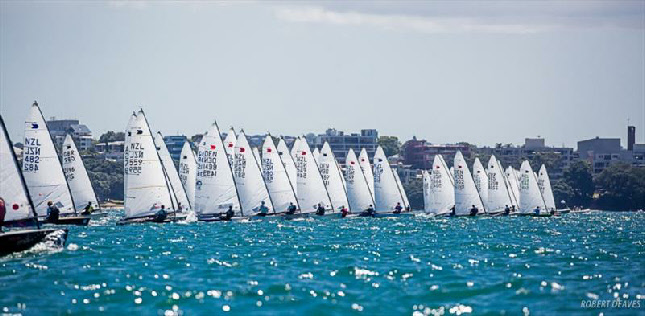
Right at the start the rule book talks about sportsmanship and playing 'fairly'. 'Us oldies' still understand the meaning behind the older phrasing, 'gentlemanly conduct', but that has never been sufficient.
A glance at the title picture above, of a race 'start', with all the boats on starboard tack, will remind you of the need for discipline. Try sailing through that start on port tack.
It is not unusual to find yourself amongst a fleet of 230+ boats at a dinghy class championship meeting. You do need to know how the boats around you are likely to react. It's a bit like "Keeping Left" when driving. With everyone going in the same direction safe progress can be made and chaos is avoided.
However, it's worth noting that, on the water, if you can cross the fleet, on port tack, from the windward end of the start line, without 'giving offence', you will be applauded for your skills!
During a recent race our 'sportsmanship' while 'rounding a mark' has been tested. Our training has covered the simple 'outside boats give inside boats room to round', but occasionally things can become alarmingly more complicated. Think for a moment of the familiar situations you meet driving your car onto a round-about: say, up at the A27 on route to Portsmouth.
1. Round-about clear: enter round-about and stay in left-hand lane.
2. Give way to a vehicle with rights and then make your rounding.
But on some occasions:
3. The round-about is busy: do not barge in. Slow down and jump in when possible without causing other drivers to 'give way'.
4. The round-about is jammed with traffic (Week End of Speed again?) wait in the queue - or turn round and find another route.
On the water Case 3 translates as, 'keep going if you have an overlap four boats lengths before the mark, or if the boat in front makes a wide rounding and leaves you room to round, inside, without causing him to alter his course or 'give way'.
Road rage set in during the April club race when many of us met case 4 for the first time. Three or four boats had run out of wind when attempting to round the Steps buoy and had formed an orderly queue, on starboard tack. They started to shout (a sportsman like 'hail' hopefully) at the sight of five or six other boats still having wind and baring down to 'barge in' (like Nelson at Trafalgar). This situation crops up at the best of regattas and one hears tell of large rafts of boats being formed, usually at the 'downwind' turning mark, all 'hailing' loudly, and getting physical with any boat within arm's length!
What should have happened? The on-coming fleet must either 'tack off' and circle round or 'bare away' and join the ever lengthening queue. Given enough water, you might be able to 'bare away' behind the log jam and sail past the lea of the stationary boats. Passing four or five boats in this way can be very 'helpful'!
Be ready for cases 3 and 4. It is not satisfactory to hail, "I can't help it", as you start building a nice raft of boats, or to hail, "Well you do", on being reminded that, "You can't come in there".
The answer to, "Well you do" is: "Only in case 3 above!" Using our driving analogy again: a F1 commentator at a tight corner of the racing circuit might say, "the leader has swung wide (which is either bad driving or worn tyres) and the chasing cars have overtaken on the inside". Note that no offence was committed.
If you are sure you had to 'give way', in such a case, just say so and the 'barging' skipper will do a sportsman like 360 turn: off the course, naturally!
Peter T B Fisher 24th Aug '19
Micro Magic Kit built by Simon Bell 2018
Introduction
The design of the Micro Magic is the work of Thomas Dreyer, an IOM and Marblehead sailor who wished to create a smaller more affordable model that would sail as well as the large racing models.
The yacht is offered in kit form by the German manufacturer Graupner. The Micro Magic is 53.5cm long and is very robust and easy to transport.
I bought the carbon version as I liked the look of it, it was actually cheaper than the white plastic version and I soon found out why!
Construction
The carbon version is actually made of clear abs with the inside sprayed with a special paint pattern that looks like carbon fibre.
I found that when parts were glued to the inside of the hull they could sometimes be detached, the paint was coming away from the hull and so the surface needed to be sanded to get a good bond.
Unfortunately when the surface was sanded the carbon look was spoilt!
The hardest part is the bonding of the deck to the hull, as you can see below a lot of elastic bands have to be fitted quickly before the glue dries!
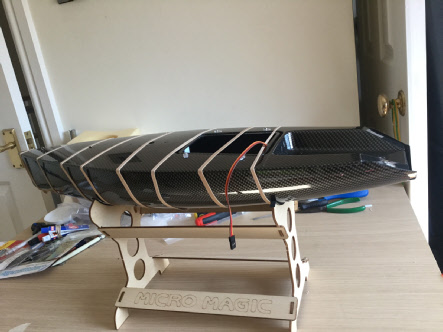
Sailing
The yacht is good fun to sail and can cope with a wide range of wind strengths, its light weigh helps it to accelerate during gusts and the soft sails are excellent for detecting wing shifts. It responds much quicker than a Victoria and when it was raced with another Micro Magic the results were very close each time. Let’s hope we see more of these little yachts on the pond.
|
|
|
|
|
|
